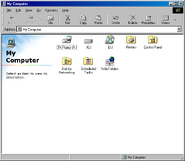The Second Edition has finished development on April 23, 1999, with the code number 4.10.2222. When it was released on May 5, 1999, it also became available as a separate upgrade from Windows 3.1, 95, and 96. Both the clean installation and upgrade were sold at a retail price of $109.00. Here, I will show you Windows 98 SE with a resolution of 1024x768 pixels, on a 24 GB HDD and 256 MB of RAM. Ever since it was released, Windows 98 Second Edition was largely criticized by PC users of Windows 95 and 96, especially when it mostly got "one-star" reviews at Amazon.com.
How to use Windows 98 SE[]
The Startup logo is completely the same as the first edition of Windows 98. I mean, why couldn't they put the words "Second Edition" under the Windows 98 logo? Anyway, you will still get the same Enter Network Password screen, so go ahead and type it to move on. Here's the differences between the first edition of Windows 98 and this Second Edition:
- The Windows Explorer now includes "Web Folders".
- Windows 98 SE includes Outlook Express 5.0. Changes are made here. The "Compose" tab is changed to "Message". In fact, all the toolbars look different.
- In the Control Panel, "Game Controllers" is now named "Game Options", the word "Internet" is now "Internet Options", and there's a new item -- ODBC Data Sources.
- Although it isn't much of a difference, Windows 98 SE is the last OS to include MS-DOS 7.10. Once again, you get the same games as Windows 95, so it's not much re-mentioning them. This especially goes for the main accessories seen on the original Windows 98, which are not changed.
- In the System Tools folder, Compression Agent and DriveSpace are removed.
- Only one application in the Entertainment folder has changed -- Windows Media Player. You are now using Version 6.4, which would later be re-released as Media Player Classic on Windows XP and Vista. With WMP 6.4, you can now play Windows Media files (.WMA and .WMV), but you can temporarily no longer play MP3s, QuickTime and RealMedia files.
- Finally, there's Internet Explorer. The version you're using here is Internet Explorer 5.0, released on March 18, 1999, which is included on Windows 98 SE, and code numbered 5.00.2614.3500. It is also available for download on Windows 3.1, Windows 95, Windows 96, and Windows NT. Speaking of which, this is the last version supported for Windows 3.1, NT 3.1, and 3.5x.
Of the following changes, they are between Internet Explorer versions 4 and 5:
- The "Go" tab is replaced by "Tools".
- You can import and export information to other applications.
- Change the text size and font on webpages.
- You get three automatic Favorites -- MSN, Radio Station Guide, and Web Events.
- The Security tab in the Internet Options has different designs.
- If you go to "Content", you'll find that the Certificates and Personal Information sections contain different buttons.
- The Connection Wizard does different things.
- The "Programs" section now allows you to change the HTML editor.
- When watching Flash objects, you'd have Macromedia Flash Version 3, released in 1998.
Due to the lots of changes between Internet Explorers 4 and 5, I recommend that you go for the Second Edition of Windows 98 instead of the original edition. You can even play DVDs on your CD-ROM drive if you have the proper DVD software installed. Otherwise, it's not gonna work. And let me say one more important thing -- RPC-1 drives can play all region DVDs for an unlimited number of times, while RPC-2 drives will lock the region of the player after being changed 4 or 5 times. RPC-2 drives began being used while people were still using Windows 98 SE.
Weblinks[]
- http://microsoft.com/windows98/highlights/windows98se.asp (June 1999–August 2000)
Gallery[]
| Operating systems | ||
|---|---|---|
| Microsoft | DOS | 1.x (1981) • 2.x (1983) • 3.x (1984) • 4.0 (1988) • 5.0 (1991) • 6.0 (1993) • 6.22 (1994) |
| Windows | 1.0 (1985) • 2.0 (1987) • 3.0 (1990) • 3.1 (1992) • 95 (1995) • 98 (1998) • 98 SE (1999) • Millennium (2000) | |
| Windows NT | 3.1 (1993) • 3.5 (1994) • 4.0 (1996) • 2000 (2000) • XP (2001) • Vista (2006) • 7 (2009) • 7.1 (2011) • 8 (2012) • 8.1 (2013) • 10 (2015) | |









